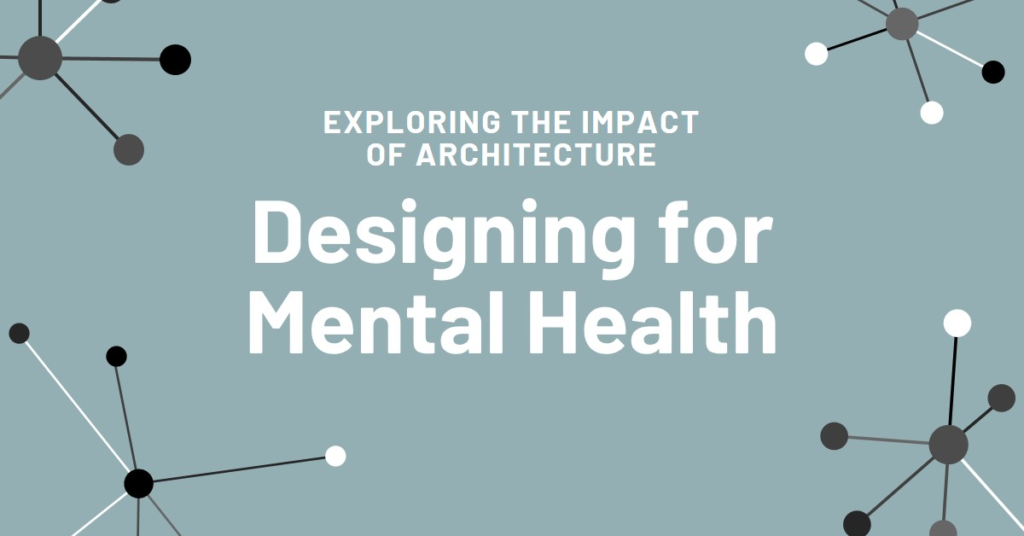
Table of Contents
Introduction: Architecture
In the bustling realm of architecture, where form meets function, lies an often overlooked yet profound aspect: its influence on mental health. Beyond merely sheltering inhabitants, architectural design possesses the power to shape emotions, behaviors, and overall mental well-being. From the layout of spaces to the choice of materials, every architectural decision can either enhance or detract from our psychological equilibrium. In this comprehensive exploration, we delve into the intricate interplay between architectural design and mental health, uncovering the strategies and principles that foster environments conducive to holistic wellness.
Creating Serene Sanctuaries:
The quest for tranquility in an increasingly chaotic world has propelled architects to prioritize serene design elements. Incorporating natural light, biophilic elements, and open spaces, architects craft sanctuaries that soothe the mind and replenish the spirit. A study by the University of California, Berkeley, revealed that exposure to natural light can reduce stress and enhance mood, underscoring the pivotal role of daylighting in architectural design. Furthermore, integrating biophilic elements such as indoor plants and green walls not only improves air quality but also fosters a profound connection with nature, promoting mental rejuvenation.
Fostering Social Connectivity:
Human beings are inherently social creatures, craving connection and belonging. Architectural design plays a pivotal role in facilitating social interactions and nurturing a sense of community. By creating inviting communal spaces, such as courtyards, plazas, and shared amenities, architects foster opportunities for spontaneous encounters and interpersonal engagement. Research published in the Journal of Environmental Psychology suggests that well-designed communal areas can foster a sense of belonging and reduce feelings of isolation, particularly in densely populated urban environments. Additionally, incorporating flexible spaces that adapt to diverse social activities enables individuals to tailor their environment to suit their social preferences, empowering autonomy and fostering positive social interactions.
Designing for Mindful Living:
In an era characterized by constant distractions and digital overload, architectural design can serve as a catalyst for mindful living. By promoting spaces that encourage introspection, reflection, and mindfulness practices, architects empower individuals to cultivate a deeper awareness of their thoughts and emotions. Integrating dedicated meditation rooms, quiet alcoves, and contemplative gardens provides inhabitants with havens for introspective retreats amidst the hustle and bustle of daily life. A study published in the Journal of Urban Design and Mental Health found that access to quiet spaces within urban environments can significantly reduce stress levels and improve overall well-being, highlighting the importance of incorporating mindful design principles into architectural projects.
Enhancing Accessibility and Inclusivity:
Inclusive design principles are paramount in creating environments that prioritize the needs of all individuals, regardless of age, ability, or cognitive function. Architects must embrace universal design concepts to ensure that spaces are accessible, adaptable, and welcoming to diverse populations. Implementing features such as ramps, elevators, and tactile signage not only enhances physical accessibility but also promotes social inclusion and equity. Moreover, considering the sensory experiences of occupants, such as acoustics and lighting, can mitigate sensory overload and create environments that accommodate individuals with sensory sensitivities or neurodiverse conditions. By championing inclusivity in architectural design, professionals can create spaces that empower and uplift every individual, fostering a more equitable and compassionate society.


Promoting Biophilic Design:
Biophilic design harnesses the innate human affinity for nature to create environments that foster well-being and vitality. By integrating natural elements, patterns, and materials into architectural design, practitioners evoke the restorative qualities of the natural world, enhancing cognitive function and emotional resilience. Incorporating elements such as water features, living walls, and organic materials not only enhances aesthetic appeal but also promotes physiological and psychological benefits. Research published in the International Journal of Environmental Research and Public Health suggests that exposure to biophilic design elements can reduce stress, lower blood pressure, and improve cognitive performance, reaffirming the profound impact of nature-inspired architecture on mental health.
Embracing Sustainable Practices:
The pursuit of sustainable architecture aligns harmoniously with the promotion of mental well-being, as both endeavors prioritize the health of individuals and the planet. By prioritizing energy efficiency, resource conservation, and ecological stewardship, architects contribute to a healthier built environment that nurtures both physical and psychological wellness. Sustainable buildings, equipped with ample daylighting, natural ventilation, and green infrastructure, not only reduce environmental impact but also enhance occupant comfort and satisfaction. Research published in the Journal of Cleaner Production suggests that occupants of green buildings report higher levels of satisfaction, productivity, and overall well-being compared to those in conventional buildings, emphasizing the symbiotic relationship between sustainable design and mental health.
Embodying Cultural Sensitivity:
Architecture serves as a tangible expression of culture, heritage, and identity, reflecting the values and aspirations of communities. Embracing cultural sensitivity in architectural design entails honoring diverse traditions, customs, and belief systems to create environments that resonate with their inhabitants on a profound level. By engaging with local communities and incorporating vernacular architectural elements, architects can imbue spaces with a sense of authenticity and belonging, fostering cultural pride and social cohesion. Moreover, designing with cultural sensitivity entails acknowledging the historical significance of sites and structures, preserving their integrity and memory for future generations. Through mindful engagement with cultural contexts, architects can create inclusive and empowering spaces that celebrate the rich tapestry of human experience.
Conclusion:
In the intricate dance between form and function, architectural design emerges as a potent force for promoting mental health and well-being. From fostering social connectivity to embracing sustainable practices, each architectural decision reverberates through the fabric of our lives, shaping our experiences and nurturing our spirits. By embracing principles of serenity, inclusivity, and cultural sensitivity, architects wield their craft as a catalyst for positive change, crafting environments that inspire, heal, and elevate the human condition. As we navigate the complexities of the built environment, let us endeavor to create spaces that not only shelter bodies but also nourish souls, embodying the timeless quest for holistic well-being.


